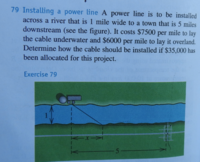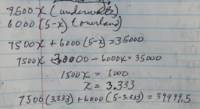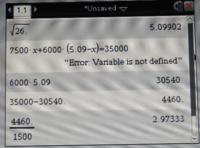allegansveritatem
Full Member
- Joined
- Jan 10, 2018
- Messages
- 962
Here is problem:

Here is my solution:

and here is solutions book solution:

I really can't follow this solution from the authors. I get the sense that they are forming a quadatic equation out of the data but I just can't follow this past the first line. I get the feeling that this is a high teck way of doing what I did. I got the approximate and the books gives the exact. Can someone unpack this book solution for me. I wonder if I need to put aside this precalculus book and maybe find a book that is a kind of preprecalculus book?

Here is my solution:

and here is solutions book solution:

I really can't follow this solution from the authors. I get the sense that they are forming a quadatic equation out of the data but I just can't follow this past the first line. I get the feeling that this is a high teck way of doing what I did. I got the approximate and the books gives the exact. Can someone unpack this book solution for me. I wonder if I need to put aside this precalculus book and maybe find a book that is a kind of preprecalculus book?

